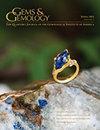Geographic Origin Determination of Emerald
IF 1.6
3区 地球科学
Q2 MINERALOGY
引用次数: 20
Abstract
GEMS & GEMOLOGY WINTER 2019 When the Spanish conquistadors first brought Colombian emeralds (figures 1 and 2) onto the international market, they became a global sensation in their day. Emeralds from Central Asia and Egypt were known at the time, but the world had likely never seen emeralds of such high quality and size. Traders soon developed distribution channels that brought the Colombian material all the way from the royal courts in Europe to the powerful Moguls of India (Giuliani et al., 2000). The nineteenth and twentieth centuries saw all of this change as new mines sprang up around the world to challenge the famed Colombian emeralds. Most notable in terms of high-quality production were Brazil, Russia, and Zambia, but smaller deposits have been uncovered in Madagascar and Ethiopia and elsewhere. As the market has evolved alongside these developments, geographic origin has come to be an important factor for fine-quality emeralds. The demand for emerald origin determination was initially driven by the proliferation of sources. However, this expansion and diversification of emerald sources has also complicated origin determination. As the number of sources grows, so does the overlap in their characteristics. The following sections will detail the specific criteria used in the laboratory at GIA to make geographic origin conclusions for emeralds, as well as potential areas of overlap and how these are dealt with.翡翠的地理成因测定
当西班牙征服者首次将哥伦比亚祖母绿(图1和图2)带入国际市场时,它们在当时引起了全球轰动。来自中亚和埃及的祖母绿在当时是已知的,但世界上可能从未见过如此高质量和大小的祖母绿。商人们很快开发了分销渠道,将哥伦比亚的原料从欧洲的皇家宫廷一路带到强大的印度大亨手中(Giuliani et al., 2000)。19世纪和20世纪见证了所有这些变化,世界各地涌现出新的矿山,挑战着著名的哥伦比亚祖母绿。在高质量生产方面最引人注目的是巴西、俄罗斯和赞比亚,但在马达加斯加、埃塞俄比亚和其他地方也发现了较小的矿藏。随着市场的发展,地理产地已成为高品质祖母绿的重要因素。对祖母绿产地测定的需求最初是由产地的增加所驱动的。然而,祖母绿产地的扩大和多样化也使产地确定变得复杂。随着源数量的增加,其特征的重叠也在增加。以下部分将详细介绍GIA实验室用于祖母绿地理原产地结论的具体标准,以及潜在的重叠区域以及如何处理这些标准。
本文章由计算机程序翻译,如有差异,请以英文原文为准。
求助全文
约1分钟内获得全文
求助全文
来源期刊

Gems & Gemology
地学-矿物学
CiteScore
2.90
自引率
19.20%
发文量
10
期刊介绍:
G&G publishes original articles on gem materials and research in gemology and related fields. Manuscript topics include, but are not limited to:
Laboratory or field research;
Comprehensive reviews of important topics in the field;
Synthetics, imitations, and treatments;
Trade issues;
Recent discoveries or developments in gemology and related fields (e.g., new instruments or identification techniques, gem minerals for the collector, and lapidary techniques);
Descriptions of notable gem materials and localities;
Jewelry manufacturing arts, historical jewelry, and museum exhibits.
 求助内容:
求助内容: 应助结果提醒方式:
应助结果提醒方式:


